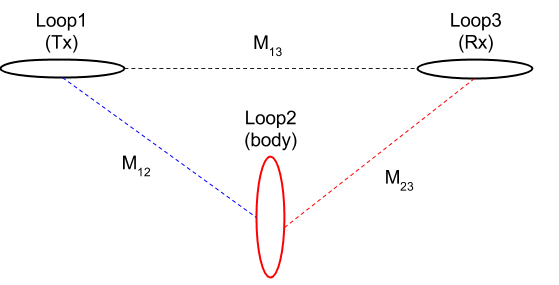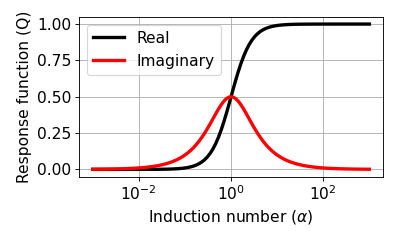Derivation of Response Function
Consider a simple equivalent circuit as shown in Fig. 90.

Fig. 90 Conceptual diagram for 3-loops system.
Let us suppose that alternating current, \(I_1 e^{\imath \omega t}\) is made to flow in the Tx (Loop 1). This current generates an alternating magnetic field in the surrounding environment, which in turn induces an EMF both in the body (Loop 2) and the Rx (Loop 3). These EMFs are governed by Faraday’s Law
where \(\mathcal{E}_j\) is the EMF induced in one circuit by a current \(I_i\) flowing in another if \(M_{ij}\) is their mutual inductance. The EMF induced in the Rx is therefore
and the EMF induced in the body is
We must add \(\mathcal{E}_2^{\dagger}\), the sum of the voltage drop across the resistance of the circuit and the back EMF generated by the self inductance when a current \(I_2 e^{\imath\omega t}\) flows around the body. For this we consider RL circuit as shown in Fig. 91.

Fig. 91 Conceptual diagram of RL circuit.
The electrical impedance of the RL circuit can be written as
where \(R\) and \(L\) indicate resistance and inductance, respecitvely. Using Ohm’s law we obtain
To find the current \(I_2\), we observe that around any closed circuit the total EMF must vanish i.e.
and therefore
This is the solution for the eddy current induced in the body (Loop 2). However, we are interested only in the secondary magnetic field which this current produces, and particularly in the EMF which the field induces in the Rx (Loop 3).
In most cases the apparatus measures this anomalous voltage by comparing it with the EMF induced by the primary field in the absence of the circuit; that is, it measures \(\mathcal{E}_3^s / \mathcal{E}_3^p\). Thus the EM response of the buried loop, is given by
The EM response is composed of two parts: coupling coefficient, C and response function, Q, which can be written as
and
We can redefine this using time constant \(\tau = L/R\)
or by using induction number \(\alpha = \omega \tau\)
Below figure shows real and imaginary component of \(Q\).
(Source code, png, hires.png, pdf)

From similar derivation we could obtain
where \(H\) stands for the magnetic field. Therefore, the equality:
holds hence fields and voltages can be used interchangeably when measuring with a coil.